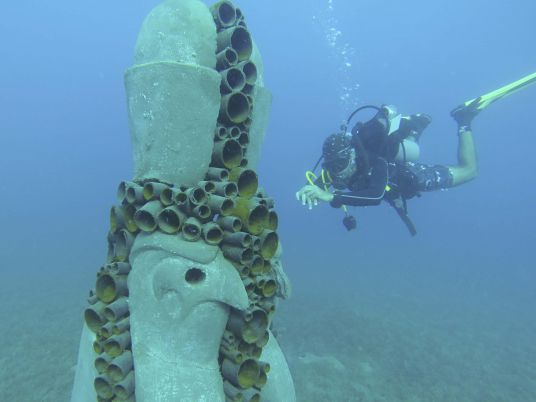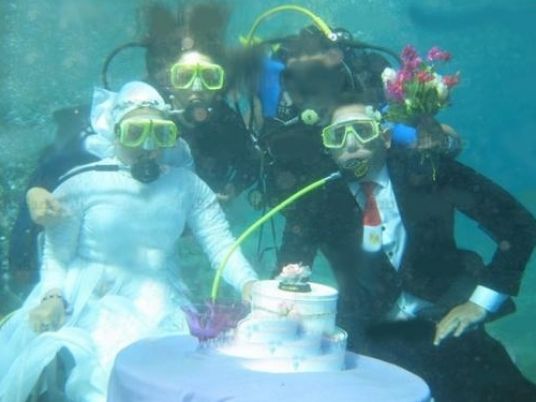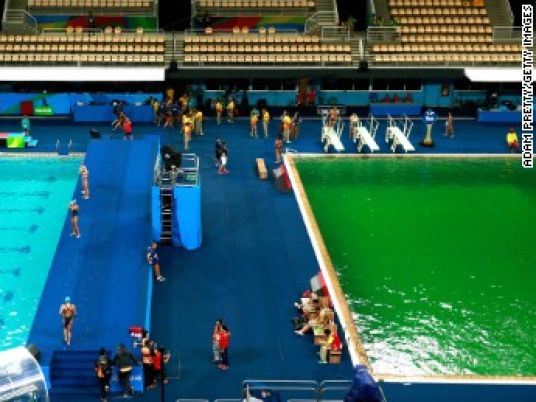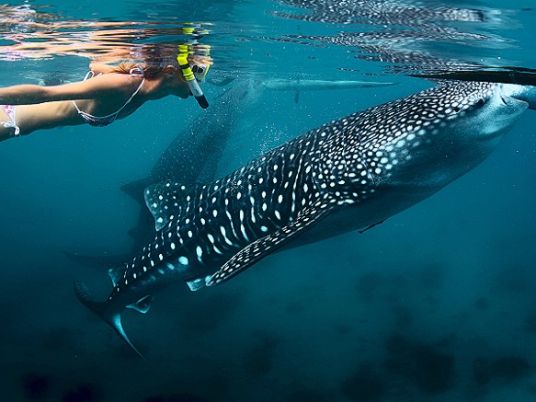A waning moon means the night will be dark. The boat is aflurry with activity nevertheless. We've been doing this all day long: putting on, jumping in, coming out, taking off. But this time is special: it's to be done under the cloak of night.
Amr takes my hand to steady me as I step into the zodiac. With eight kilograms of lead weights around my waist, an air tank on my back and flippers under my arms, clumsiness is almost a given. We balance ourselves on either side of the inflatable boat, all trying to rest our air tanks against the sides to lighten the load on our backs.
Amr steers the motor-powered zodiac away from the dive boat into the calm dark sea. My friends are quiet but their excitement is palpable. We all make one last check of our equipment: flippers on, weight belts on, arm computers set, goggles properly cleaned and ready around our necks, tanks open, vests emptied of air, and flashlights secured around our wrists.
Someone theatrically says, “The Way to Eilat”–a reference to an Egyptian movie from 1995 which portrayed a night operation carried out by Egyptian Navy Seals to blow up Israel’s Eilat Harbour in 1969, when the two countries were at war. We all laugh.
We reach our destination, marked by the wreck of the Panamanian cargo ship Loullia, which ran aground in 1981 on the northern end of Gordon Reef, lying in the Strait of Tiran at the mouth of the Gulf of Aqaba in the Red Sea.
Amr tells everyone to get ready. "Three, two, one," he calls, and we all allow our heavy backs to pull us backward into the dark waters. It takes a few brief seconds to become oriented: Up and down are not immediately clear. We do not resurface as we normally would–the plan is to meet below at five meters.
Flashlights on, I search for my friends and find them immediately, all five of them. We set out on our way to explore Gordon Reef’s nightlife.
By no means can diving be considered a cheap activity. It is, however within the means of Egypt’s growing upper middle-class. Even so, Egyptians are hard to find among the bustling boats moored around the country’s many diving sites.
Diving requires an international diving license, awarded after taking a diving course. Courses are available at any of a myriad of diving centers along Egypt’s shores. A typical diving course costs something in the range of LE1500 to LE2000 and takes three days. It includes theoretical coursework, through which you are introduced to diving, the equipment, diving tables, and information on currents, underwater communication, and underwater safety.
The first dive is done in a swimming pool in order to start the prospective diver off feeling comfortable breathing air underwater in a known and controlled environment. Subsequent dives are done in the sea.
The first diving license is issued upon successful completion of the coursework and of five underwater dives.
And that is only the beginning. More courses can be taken in underwater navigation, shipwreck diving, deep sea diving, altitude diving (diving in lakes at high altitudes), rescue diving, and more.
A first course is more than enough to be able to appreciate the wonders of Egypt’s marine life however. And diving equipment can be rented from diving centers for around LE400 for three days, depending on your needs.
If you haven’t yet dived in Egypt, you are missing out on a significant portion of the country and you are yet to discover Egypt’s full diversity and beauty. The Red Sea boasts 1248 species of fish and some 250 species of coral.
Besides the Red Sea’s vibrant sea life, the underwater landscapes themselves are breath-taking, with caves, canyons and underwater rock formations formed over millions of years all waiting to be explored.
Thomas Reef in the Strait of Tiran is one of the most spectacular diving sites in the northern Red Sea.
My diving buddies and I set out just as the sun is rising and gradually dive to 30 meters. A strong current pushes us along the reef, allowing us to save our energy and breath as we drift in a south-easterly direction.
Huge fan-shaped corals loom to our left, as high as the tallest of us and as wide as a man stretching his arms and legs as far as possible–yet thin as a ballpoint pen.
The current quickly carries us away from the double line of gorgonians. Our guide signals to us to fin. He has caught sight of something interesting it seems.
We swim with the current and come up against a whitetip reef shark carelessly swimming by. For most of us, this is our first shark sighting, and we are very excited.
We stop in our tracks–or wish we could; the shark is effortlessly swimming against the current in the opposite direction. I reach for my diving buddy, who is being pulled away by the moving waters.
We hold on to each other as we struggle to swim toward the shark against the current to get a better look. We fail. The current is too strong and it continues to carry us away from our most exciting sighting of the day.
It's not long until we see a small sea turtle, the size of a bike tire, feeding on the corals. We all move into the corals where the current can’t exert its forces on us as strongly and we practice our skills of lying motionlessly underwater to watch it.
Only a few more meters away we see what we assume is the little one’s mother–or perhaps great, great grandmother: a huge sea turtle the size of a truck tire. Commotion breaks loose among the group of Egyptian divers as we all signal to each other to get a look at the aging diva.
It’s not only the largest of the underwater world that are able to grasp the imagination. Some of the Red Sea’s smallest creatures are its most exotic.
At Ras Umm Sid at the very beginning of the Strait of Tiran, we catch sight of a Spanish dancer. This small sea slug is barely the length of half a finger. With its spotted back and paper-thin undulating body, it looks like a micro-flying carpet of the open seas.
In Colorado and the Alps, people ski and hike. In Hawaii, people surf. Egypt’s diving sites are bested only by the Great Barrier Reef in Australia.
In Egypt, more Egyptians should have the chance to dive.




